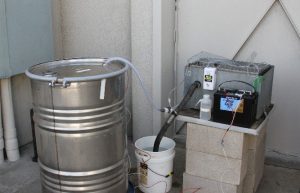Preliminary testing completed for L.A. River fish flow-through study

SCCWRP and its partners have completed preliminary testing for a field study that involves exposing fish to flowing river water in real time to study potential biological impacts from exposure to CECs.
The pilot project, which marks the first use of mobile exposure units for a Southern California water-quality study, will enable researchers to replicate environmental conditions more accurately than exposing fish in a lab setting. Researchers are setting up mobile exposure units along stream banks to pump water in real time through chambers that house adult male fathead minnows.
The preliminary tests, completed in April, showed that fish health is not being compromised by the mobile exposure units, with water flow and water-quality parameters remaining within acceptable ranges and no fish mortality.
For the main pilot study, which will kick off in mid-August, SCCWRP is collaborating with City of Los Angeles Bureau of Sanitation to establish mobile exposure units at two Los Angeles River sites – one just downstream of the L.A.-Glendale Water Reclamation Plant, and one in the Sepulveda Basin just upstream of the Tillman Water Reclamation Plant that receives urban runoff.
Researchers hope to learn whether CECs – which can be found in both treated wastewater effluent and land-based runoff – trigger biological changes in fish, including to gene expression patterns, tissue integrity and sex characteristics.
The study is being launched as water-quality managers increasingly focus on how CECs in freshwater systems could be affecting the health of aquatic organisms.
More news related to: Bioanalytical Cell Screening Assays, Emerging Contaminants